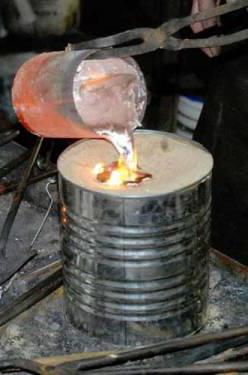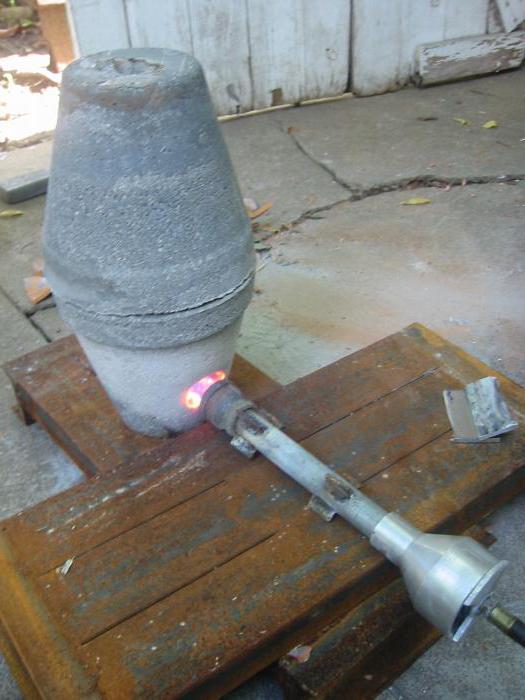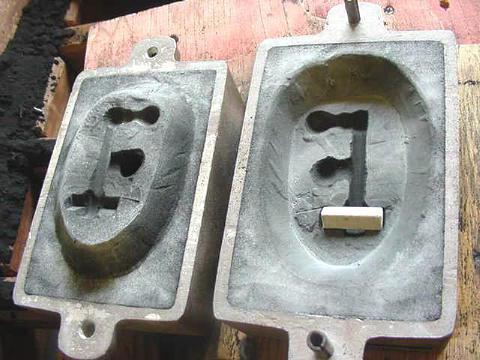In childhood, many tried to melt lead. Material could be found in used batteries. He quickly melted in a bonfire and poured well into simple forms. Casting aluminum at home is also possible. This metal is more practical and is of particular interest to original craftsmen. However, for casting, it is necessary to provide twice the temperature, and the fire of the fire will not be enough for this.
Aluminum: specifications
This metal was considered precious before the discovery and implementation of an affordable method of industrial production. At a certain historical stage, it was more expensive than gold. Its properties could be used in many industries. Aluminum is a light and plastic material. It lends itself to stamping, bends, pours well into complex shapes, especially under pressure. Its melting point is 660 ° C, it can be achieved without industrial equipment. So, casting aluminum at home is quite possible.
Who needs this? Aluminum is a proven material. Both dishes and parts for the aviation and space industries were made from it. Castings with good thermal conductivity, corrosion resistance and acceptable strength are appreciated by lovers of tinkering. The material is suitable for the manufacture of souvenirs, decorative items for utensils, for repair or restoration of parts and assemblies in technology.

Aluminum casting at home
It is possible to achieve the melting temperature without using industrial technologies in various ways. In the old days, blacksmiths forged steel and heated it with the energy of coal burned. This is the first option, but for its implementation you will need a furnace with forced air supply.
The second option is to use natural or liquefied gas. The process can be organized in a home-made oven. There is another possibility if the melting volumes are negligible. In this case, you can use a household gas stove.
Casting aluminum at home can also be arranged if the farm has an acetylene generator and a cutter. An option with an electric muffle furnace is also suitable. Such equipment can already be attributed to industrial. But if there is no desire to make a furnace, it is quite possible to rent it and order the operator’s service.
Technological process
In principle, the situation of industrial casting should be modeled with a reservation on home conditions. In any case, it is necessary to prepare the raw materials. Scrap aluminum is cleaned of dirt, foreign impurities, all kinds of fillers. Large pieces are crushed to the desired size.
Aluminum casting technology consists of several stages. Prepared scrap is melted in the selected manner. Upon reaching the fluid phase, slag is removed from the surface of the melt. In the final phase, the form is filled with liquid metal. Disposable form breaks after cooling.
First you need to decide what to cast. Even if this is a trial attempt to melt, it makes sense to prepare at least some form. What if you can reach the desired temperature? It is interesting to see the result of melting and evaluate the results: appearance, porosity, purity. Any experience, even unsuccessful, will benefit.
Conditions and equipment needed
When melting secondary raw materials, the coating burns out, fumes are emitted, there is smoke. It is problematic to work indoors without intensively functioning hoods. The best option is open space.
Even in this case, an additional ventilation source will be useful. Molding of aluminum into polystyrene foam is accompanied by an intense release of combustion products. A fan with side blowing of the workplace will remove caustic smoke, which will provide normal conditions for casting.
An equipped and well-thought out workplace is also important. It is desirable to have sheet metal or another surface on the table that is not amenable to the high temperature of molten aluminum. The likelihood of splashing and spilling liquid mass is high. With this in mind, you should think about the need for work in a residential setting.
Homemade Melting Furnace
The easiest way is to take a few refractory bricks and lay out a hearth from them. This is convenient to do in a suitable metal container (old pan), which will be used as a frame. A hole is made on the side for supplying an air supply pipe. A suitable diameter piece of metal pipe can be adapted. A vacuum cleaner hose, hair dryer or other air supply device is connected to it.
Charcoal (coal) is laid inside. The fire is kindled, the air supply is turned on. The vessel where the aluminum will melt is installed inside the furnace. From the sides it is also lined with coal. It is advisable to make a lid on the oven so that the heat does not go away in vain, and leave only a hole for exhausting smoke.
Ideally, the firebox is made integral with an oval arch. Use special mixtures for laying heat-resistant bricks and lining furnaces. This design can be built from an old bucket. The inner vault is formed using suitable sized plastic flower pots. Inside the reinforcing mass, a metal mesh can be embedded. After the mixture has hardened, a solid furnace will be able to withstand more than one melt.
Using a stove
Piece casting from aluminum can be arranged without the manufacture of a special furnace. The required temperature is achieved using domestic gas. The melting process itself takes about half an hour if the volume of aluminum does not exceed 100-150 grams.
As a container use a can of condensed milk, for example. Peeled and crushed aluminum scrap is poured into it. But to melt it by putting a tin can on the grate above the burner will not work - there will not be enough temperature. To reduce the loss of thermal energy, the inventors came up with a cunning design.
A can with raw materials for melting is placed inside another tin and installed on spacers so that there is a gap of 5-10 mm from bottom to bottom and from sides to walls. The second can, respectively, should be of a larger diameter. A hole is made in it from below (diameter 3-4 cm) for supplying a jet of flame. The divider from the burner of the gas stove is removed.
The flame is ignited. The design is installed strictly above its wick. The flame should pass inside and warm only the tin with a crowbar. A can of larger diameter acts as a shell and retains heat inside. From above the opening is covered, only a gap is left for the exit of combustion products. The burning rate is adjustable.
Crucible and accessories
A can can withstand one heat. Its further use is possible, but already at the risk of being burnt. In this case, the molten aluminum runs the risk of getting inside the stove, which is not only fraught with clogging of the burner nozzles.
To work in a furnace operating on coal or liquefied gas, and indeed for reusable melts, it is desirable to make a special container - a crucible. It is made of steel. A piece of pipe with a brewed bottom is suitable. A good option is obtained from a cropped fire extinguisher or a small-sized oxygen cylinder with an oval arch. It is advisable to make a side chute for the convenience of pouring a thin stream.
What additional equipment for casting aluminum may be needed? Reliable pliers or their version with clamp fixings will come in handy. Ideally, the crucible can be equipped according to the principle of industrial designs: with lateral grips of a removable suspension and a lower fixed stop for the convenience of turning it over. Need a spoon with a long handle to remove slag from the surface of the melt.
Simple forms
What are the ways to cast aluminum? The easiest way is to pour molten metal into a metal mold: an old mug, a frying pan, a tin can. After cooling, the disc is removed. It is easier to do this if you tapping on a form that has not yet cooled down. If it had corrugated sides or reverse angles, the frame will have to be cut. You can pour a slightly cooled drop of metal just onto a prepared fireproof surface. Such methods are called open.
If there is a need to make a special casting, first you need to prepare a mold for it in size. In order for the metal to get a clear outline after cooling, closed forms are made of two or more components. One of them is the main one, and the other usually forms a arch or side surface. Holes are made in it. Often on top of them add another part of the form - funnel-shaped flyers for convenience.
Material
Molds for casting aluminum, depending on the method, can be manufactured using different technologies. There are some simple options. For open pouring into a simple form, sifted earth (silica) is often used. It is laid in layers and rammed. After removing the forming element, the earth holds its shape and withstands pouring. Such material is simple and cheap to use.
There are craftsmen who pour aluminum into sand. When mixing using liquid glass (silicate glue). There is information about the use of cement. The mixture is kneaded, oddly enough, on the brake fluid. Warm up his hands and rubbed through a sieve so that there were no lumps. The consistency should be such that when compressed, a lump forms in the fist. When tamping, sand and cement are well kept inside the flask and repeat even small details of the shape of the workpiece.
Making complex shapes
Castings of complex configuration are made using a different technique. Most often, the material is gypsum (alabaster). Forms without reverse angles and undercuts can be collapsible and consist of two or more parts. They won’t last long, but it’s quite possible to get a few castings.
A complex knot or decorative three-dimensional model can be made once, and the shape will have to be broken. There are two methods to work with. You can make a wax (paraffin) model, fill it with gypsum. Later in the process of intensive drying, this material will melt and pour out through the summers.
The casting of aluminum into a gypsum mold on foam involves the manufacture of a model of future casting from this material. It is poured with the prepared mixture and is no longer removed. Molten aluminum is poured over. The temperature of the metal melts the foam, it evaporates in the process, and liquid aluminum fills the freed up space.
Casting Errors
Making plaster molds is a convenient and inexpensive way. But there is moisture in the material. With natural drying, it remains. When pouring molten metal, moisture begins to evaporate intensively. Even intensive drying in the oven does not guarantee its complete absence. Depending on the amount of moisture remaining in the form, the aluminum casting may have small shells or large solidified bubbles and craters.
If the metal has not been sufficiently warmed up or has cooled before pouring, aluminum does not pour out well and does not fill the mold volume. In fact, a drop forms, which does not have sufficient fluidity. The same thing can happen when using a small volume of metal in cold form. Aluminum quickly gives off heat and does not have time to spread.
Experienced craftsmen do not recommend immersing the casting in water to accelerate its cooling. In such a material, a violation of the internal structure and the appearance of microcracks are possible. For subsequent turning, such blanks may not be suitable.
Security
The technological process involves the use of open fire, which imposes additional restrictions. It makes sense to check the availability of fire extinguishing equipment, serviceability of gas appliances, ventilation in the room.
Working with molten metal is a dangerous process. All operations must be carried out in compliance with safety regulations. Mandatory overalls and respiratory and vision protection.








